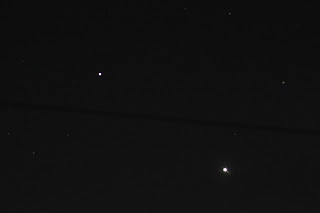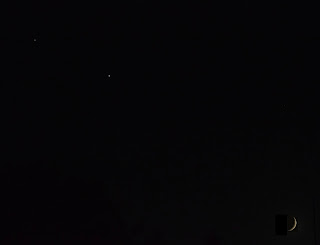November 26th 1850 GMT Moon
November 26th 1235 GMT Sun
As it was lunchtime, I just did a quick photo shoot of the
Sun in white light with my DSLR at 300mm focal length, ISO 100 and 1/4000
second exposure.
November 25th 1820 GMT Moon and Planets
November 22nd 1820 GMT Moon and Planets
I had a minor disaster when I deleted some photos in the
middle of the session, so I took them again.
I snapped the Moon with my DSLR at 300mm ISO 100 and 1/500
second exposure.
I snapped each of Jupiter, Saturn and Mars with my DSLR at
300mm ISO 100 and 1/100 second exposure. I did not catch more than a blur in each attempt.
I snapped Jupiter and Saturn together with my DSLR at 300mm
ISO 6400 and 2 second exposure.
November 21st 1405 GMT Sun
November 19th 1730 GMT Moon
November 19th 1205 GMT Sun
I saw a new sunspot on the Big Bear images, so had a punt at snapping it with my DSLR, at lunchtime.
November 18th 1730 GMT Triple Shot
My first set of shots caught all objects together.
I tried to catch the Moon showing the bright side and some details but I did not get accurate enough focus.
However, I managed to catch two of Jupiter's moons and Titan (very close to Saturn and to the right).
I managed to catch the north equatorial cloud belt of Jupiter, although the south one is even less distinct.
In the first step of digital wizardry, I resized the lunar shot, above, and put it onto the shot of the three objects together.
November 18th 1730 GMT Disaster!
November 15th 1820 GMT Jupiter and Saturn
November 14th 2230 GMT Mars
Naturally, I had been playing David Bowie music a day or two
before. October had passed without me seeing Mars and nearly half of November,
too. Conditions were poor, with lots of moving cloud of various
thicknesses. As the air was damp, I did not want to risk bringing my laptop
outside. Besides, I decided that this was primarily a visual session.
I started off with my Mak at 64x magnification, using my
32mm Plossl. I could see some albedo features. Good!
I increased the magnification to 103x magnification, using
my 15mm Moonfish Group eyepiece. It was great! Not only could I see the albedo
features more clearly but I also saw an ice cap. I tried various combinations
of higher magnification but could not see the features as well.
Knowing that low magnification was the order of the day, I
took some snaps with my Mak and DSLR at 1540mm focal length. I used ISO 100 and
400 and exposures from 1/500 second to 1/50 second. I ended up with a close approximation to what I saw.
November 12th 1205 GMT Sun
I had been following the active Sun on the Big Bear and
Learmonth images for a few days. Activity had reduced to a single, large
sunspot. I took some photos with my DSLR at 300mm focal length, ISO 100 and
1/4000 second exposure.
November 6th 1845 GMT Constellations and Meteors
November 6th 1200 GMT Sun
November 5th 1620 GMT Various
November 5th 1040 GMT Sun
November 5th 0640 GMT Moon
It was twilight but misty. The Moon was high in the south west. I took some frames at 300mm focal length, ISO 400 and 1/250 second exposure. Unfortunately, the photos were too faint.
November 4th 1510 GMT Sun
November 4th 1145 GMT Sun
November 3rd 2015 GMT Moon
Conditions were similar to the evening before, which dissuaded me from doing a meteor shot. I considered a telescope shoot but it was a bit cold outside and I was quite busy.
November 2nd 2235 GMT Moon
There was just light cloud around and the waning gibbous
moon was flooding the nightscape with light. I snapped the Moon at 300mm focal
length, ISO 100 and 1/800 second exposure.
I had a go at Mars at 1/100 second exposure, just in case I caught anything.
I didn't!
































No comments:
Post a Comment